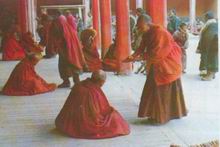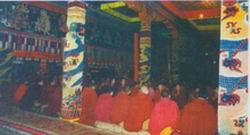Editor’s
Note Shoton (Sour Milk Drinking) Festival is held in Tibet from
the 3th day to 8th of the 6th Tibetan month (or late August).
It generally lasts for six days. With the market economy booming,
the cultural festival has been enriched to cover the exchange
of materials. 
Shoton, meaning “sour milk drinking feast” in Tibetan, is famous
in Tibet largely because it is the time to watch organized Tibetan
opera performances, while giant tangka paintings of Buddha are
also displayed. Therefore, the Shoton Festival is also known as
“Tibetan Opera Festival” and “Giant Painting of Buddha Displaying
Festival.”
The traditional Shoton Festival begins with the display of the
giant paintings of Buddha, and is highlighted by Tibetan opera
performances, public visit to parks, yak races and demonstrations
of horsemanship.
The Gelug Sect, therefore, regulated that monks should stay in
the monasteries to recite sutras between the 4th and 6th Tibetan
months. They were supposed to go out at the end of the 6th month.
Then, lay people would prepare food to entertain them. Sour milk
feasts would be held, and Tibetan opera performances organized.
It was the routine that Tibetans in their tens of thousands would
throng the Zhaibung Monastery to offer sour milk to the Dalai
Lama and monks, and in return receiving a blessing touch on their
foreheads. Local Tibetan opera performing troupes and wild yak
racing teams came to add luster to the occasion. Gradually, the
Shoton Festival came into being. 
As the Buddhist horns were blown to raise a din that echoed
through the valley where the people had gathered, close to 100
monks carried a roll of silk painting of Qamba Buddha out of the
Coqen Hall of Ta’er Monastery. They went direct to the place from
where the painting would be rolled down the slope; tree branches
were burnt to create auspicious smoke; and the people recited
sutras.
As the painting was being rolled down the slope, worshippers presented
it with hada scarves.
Measuring 30 meters long and 30 meters wide, the painting has
Sakyamuni, founder of Buddhism, in the center. He holds a metal
object in his left hand and his right hand points to the ground
with a threatening posture against devils. Around him are other
deities.
The tangka painting kept in the monastery is shown only once
a year. Hence, many call the festival “Sunning Buddha”. It would
be displayed for one hour and then brought back to the Coqen Hall.
This was followed by the staging of Tibetan opera performances
in the Front Courtyard of the Gandain Phodrang. After the opera,
the festival comes to an end.
|



